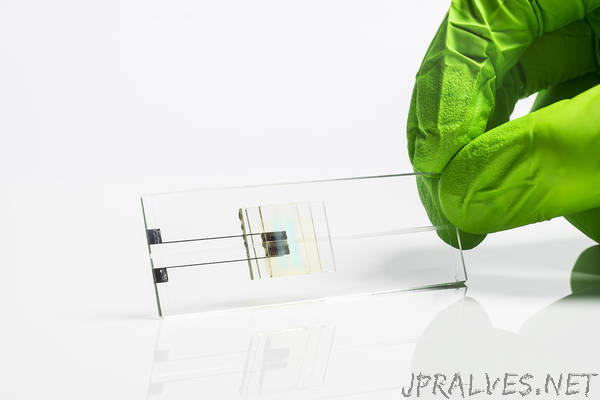
“Want to quickly test blood for pathogens? Or food for toxins? In the future, you will be able to do just that from the comfort of your own home using a small fluorescent chip and your smartphone. To make use of this method, you require a lamp and a detector – and now these could potentially be printed in large quantities using an inkjet printer. Fraunhofer IOF researchers will be showcasing the technique at the Compamed trade fair (Hall 8a, Booth P13), to be held in Düsseldorf from November 13-16.
Every mealtime it’s the same thing. Your child clutching their stomach and complaining about tummy ache. You as parents are at your wits’ end, and nothing you try from your home medicine cabinet is having any effect. Could it be that your child is suffering from celiac disease – gluten intolerance? Previously, you would have had to go to a specialist doctor to find an answer to these sorts of questions. Now, though, Fraunhofer researchers have another vision: a simple test that involves adding a drop of blood to a small disposable chip, and getting the results via smartphone app within minutes. The re-
searchers want to develop these kinds of chips to detect other illnesses, as well as to use them to guarantee food safety, for instance by detecting specific toxins.
Printing the lamp and photodetector
These chips are being developed by researchers at the Fraunhofer Institute for Applied Optics and Precision Engineering IOF in Jena together with industry partners. The industry partners provide the chips, which come with tiny channels. The Fraunhofer scientists then supply the chips with the necessary optics. “We imprint a lamp as well as a photodetector – using a conventional, only lightly modified inkjet printer,” explains Falk Kemper, a researcher at Fraunhofer IOF. The key is that the researchers use a special sort of ink that contains fluorescent polymers or nanoparticles.
Here is how the chips work: When the mother adds a drop of her child’s blood to the chip, tiny channels on the surface of the chip guide it so that it mixes with special anchor molecules as well as with a fluorescent dye. When testing for celiac disease, the anchor molecule will bind only to celiac disease markers; all other molecules will be allowed to pass on. As for the fluorescent dye, this attaches itself right at the top of the “stack” of anchor molecules and disease markers. Again, it will only attach itself to the specific disease markers. At this point, the inbuilt lamp causes the fluorescent dye to glow. In other words, if the photodetector “sees” fluorescent light, then the disease marker is present – and the child is diagnosed as suffering from celiac disease. However, if the child is unaffected by celiac disease, the fluorescent dye does not bind to the molecules and is simply filtered through. The chip remains dark.
The special ink and its layered design
Four different special inks make it possible to imprint the lamp and detector on the chip. “Both the lamp and the detector have essentially four layers: an electrode at the bottom, an active polymer layer, another electrode and then a fourth filter layer,” says Kemper. When the lamp’s electrodes are exposed to an electric current – plugged in, if you like – the polymer layer glows and emits light. The problem is that the detector doesn’t know whether that light is coming from the lamp or from the dye – which is where the filters come in. One filter sits on top of the lamp and allows only blue light through. Meanwhile, the dye glows yellow – and the filter on the detector allows only yellow light through. In other words, the detector is blind to the blue light that stimulates the lamp.
Cost effective, broad appeal, conserves materials
Until now, this sort of fluorescence testing has required a comparatively extensive and expensive apparatus. “By printing the chips using an inkjet printer, we are progressing towards a cost-effective way of producing fluorescence sensors quickly and efficiently. Our method also conserves material and resources, since we only apply the material precisely where it is required,” says Kemper. Another advantage is that it is just as cost effective to manufacture a single chip as it is to mass produce them using a roll-to-roll technique.
At the Compamed trade fair, to be held in Düsseldorf from November 13-16, Fraunhofer researchers will be presenting the first prototypes of the fluorescence sensors (joint Fraunhofer booth, Hall 8a, Booth P13).”
